

 The Accurate Reloading Forums
The Accurate Reloading Forums  THE ACCURATE RELOADING.COM FORUMS
THE ACCURATE RELOADING.COM FORUMS  Rifles
Rifles  Custom Built Rifles
Custom Built Rifles  Who really builds your custom...& how much does it matter.
Who really builds your custom...& how much does it matter.Go  | New  | Find  | Notify  | Tools  | Reply  |  |
| One of Us |
Some of the best rifles in the world, can be built almost entirely by the one person, a person you get to meet and discuss your needs and desires with. Some of the other best grade rifles in the world, can be built by a crew of great talent, that you never get to meet or even know the names of, they may not even be in the same location together. Some of the best rifles from prominent names, may have some, none, or virtually all the work involved, done by the actual persons name on the product. -Some makers will buy the build components,rather than manufacture them themselves. examples; -WR,H&W,H&H,Purdey etc,- generally you dont get to meet the guys who build your rifle. Nor will you have a Purdey,Holland or Richards actually doing any of the build process on your rifle. -Darcy Echols Co., you can meet the man, but he may not be as hands on/involved in actual rifle build process, as some might hope or imagine.[Darcy does not keep such a fact,or the other workers names a secret.] -The high dollar/provenance British-European makers, Ralf Martini,Martin Hagn etc,, can have apprentices working for them,which still results in a fine product. How important is it for you to know the person who does the work? How much of the work do you reasonably expect him to personally do? does it bother you that apprentices or unknowns, work on your rifle? Is it the end product that matters most? | ||
|
| One of Us |
I suppose that would be as personal answer as asking why you wanted the custom in the first place. You have to have your own reasons for answers to both questions. I have had many custom rifles in my lifetime and almost all have been built by a single builder -- Me. I have ordered but 2 rifles to be custom built and in both cases the entire rifle was built by an individual smith who did everything himself. Both were built by friends and the whole exercise was to have a rifle built by this person not to just have a custom rifle. So your question is like so many on these forums one that can never be answered by anyone but yourself. SCI Life Member NRA Patron Life Member DRSS | |||
|
| One of Us |
Ralf Martini and Martin Hagn, are Canadian gunmakers FROM Europe, not European makers. As I have tried to tell you before, Ralf does not have and has not had any "apprentices", he now works in his shop alone, with Mandy running the paperwork and he does contract out some piece work to the two ACCG members who were working as gunsmiths, NOT apprentices, for him. Both of these gentlemen have done and are doing work for me and I speak with Ralf frequently as we have become quite friendly and I first met Mandy over 20 years ago. So, perhaps, given the precision involved in custom gunmaking, you might want to be a bit more accurate in your comments, as I doubt that Chris or Jan would appreciate being called "apprentices". I hav never heard of Hagn's taking an apprentice, granted, I have only met him once and spoken by phone once with him, but, I know several of his clients and a hunting buddy of his quite well and from their comments, I gather he works alone. I expect to go to their shops later this summer and probably arrange for more work to be done for me; I will clarify this at that time. | |||
|
| One of Us |
I did not say Ralf and Martin are European gunmakers. I simply listed them along with the British/Euro high price-provenance makers, as those in the industry that used apprentices. Unfortunately you have misinterpreted. I have never said that Ralfs ACGG member workers[Chris or Jan] are apprentices. Your perception that I have, is a figment of your own imagination. It was Ralf himself some yrs ago,that informed me [face to face] that they have utilised apprentices in the workshop. He said it gave him the oportunity to dedicate his valuable time & higher skills to the more demanding processes of a rifle build. You can dispute this fact as much as you want, but I dont consider Ralf or myself as an liar. I have found Ralf to be one of the most down to earth candidly honest and most highly talented riflebuiders ive ever met in decades. Anyway, talk to Ralf and Martin, and get back to the open forum on the matter. Have you found the web address that you claim exists- WWWW. MARTINIGUNMAKERSLTD.....? despite your claims, Ralfs current business web address is still http://www.martiniandhagngunmakers.com/ ...let me guess, yet another thing you have somehow managed to misinterpret? | |||
|
| One of Us |
I do not think that there is any misinterpretation in my post and this statement of yours is quite clear. What Ralf, allegedly, said to you and what he told me when he called me less than two weeks ago, seem to differ. I think that anyone interested can determine for themselves the facts of the situation. I would add that your writing skills are such that it is easy for anyone to be confused as to what you are trying to say, this is obvious in your posts. | |||
|
| One of Us |
Trax / Dewey, I can definitely clarify this point for you guys once and for all because I stayed In Cranbrook last year for a few months. Martin did have a full time apprentice for around 18 months or so but he didnt have the desire to continue with full time gunmaking. He is very adept with a file, his main strength. When work ran out he was let go, which suited him fine. He came down to N.Z and stayed with me and helped me file and polish 25 of my barrelled actions. I also took him hunting and he shot a big red stag, a bull thar and a sika stag, all free range. Anyway he subsequently returned to Cranbrook and has worked for both Ralf and MArtin when there is filing, polishing work to be done. He has done the majority of the filing work in those workshops in the last couple of years. There is of course nothing wrong with having a young guy who has been well trained to do the filing/ polishing work on an action. There is a very simple test for the acceptibilty of this- have an action filed up by both the apprentice and the master and then see if one can tell the difference. The other thing to bear in mind is that the senior smith will check the work and make any small touch ups if necessary. It isnt rocket science using a file, and if a small mistake is made it can usually be rectified very quickly and easily. So there you have it. There is a young skilled guy who works for both when the work is there. Just like in the British trade. | |||
|
| One of Us |
The simple point I have tried to make here is that Hagn or Ralf do not have and have not had here in Canada, "apprentices" in the correct sense of that term. An apprentice is learning the entire trade and is not merely a "contract worker" or one who does only some basic tasks related to a given trade...that is the correct usage of the term in English and is how it is used in Canada/BC in determining a tradesman's legal status. If, I "apprentice" to a "master" plumber, gunmaker or glazier, here in Canada, I am in a process which is intended to result in my becoming a "journeyman" and eventually a "master" of said trade and thus his equal. I commented on this issue to begin with as Chris and Jan ARE ACCG members, have been since they started working at Martini's, as they were accepted at about that time and are not "apprentices" under Canadian usage of that term. The point is, that, I have some issues with the credibility of anyone who posts comments that are not factually correct in an attempt to bolster his posts on any issue. It is obvious to me, given the lack of open honesty in response to a PM I sent a certain poster, that there may be a bit of "pasture pudding" in his comments......... Another aspect of this, is that small shops such as Ralf's and Hagn's do not really have the financial wherewithal to pay "apprentices" a living wage in the East Kootenays, given the job opportunities available in local resource industries. So, it is highly unlikely that they would have an apprentice and do, in fact, have contract workers as Chris and Jan are, but, who are also gunsmiths in their own right and have their independent businesses. Anyway, enough of this, my point is made. | |||
|
| One of Us |
A lot depends on one's comfort zone. I like to "Take all the credit or take all the blame" Having tried "apprentices" years ago..I just don't have the patience. My hat's off to those that do, because it's a marvelous way to pass on skills and knowledge. The epitome of a custom gunmaking shop..in my opinion, is Wells in Arizona. These folks make the entire product from the ground up...actions, barrels, stocks and in house engraving. At the other end is the guy who inlets metal work from someone else into a machined stock and farms out the checkering, calling himslf a "custom gunmaker" There's a niche for every level. | |||
|
| one of us |
Boy this thread turned into a pissing contest pretty soon (before it even started perhaps?) 1. If I am going to have any gunsmiths name on a custom gun, then it had better be a good one! 2. I would not expect the gunsmith to do everything. But he is responsible for the finished product, so, it he "subs out" any of the work then he needs to make sure that work is done under his supervision and to his satisfaction. After all his name goes on the finished product. Just my attempt to answer the OP. Peter. Be without fear in the face of your enemies. Be brave and upright, that God may love thee. Speak the truth always, even if it leads to your death. Safeguard the helpless and do no wrong; | |||
|
| One of Us |
I have a good friend who builds single shot and bolt action rifles for me. He likes 98 Mausers and Borchardts, so he has quite a bit of hand labor in reworking the M98 one to suit. He buys a barrel blank, and contours it, fits it to the action, and chambers and headspaces it. I have also had the pleasure of watching him rifle a barrel on his lathe, much as Pope and Schoyen and others did in the old days. He buys a blank, or I bring him one, and he turns it into a stock completely with hand tools. Lampblack and scrapers. He fits the barreled action to it, and checkers and finishes it himself. He will make the barrel band front sight, and barrel band sling swivel from stock as well as make the quarter ribs. Unless it it is a simple single blade rear sight (to be filed in after the load work is done; he buys it from NECG. He also does his own bluing, and browning. He will send things out to be casehardened. The finished rifle is the effort of one man. I like knowing that, and being able to drive half an hour over to his shop and watch him create things. I would consider a gunsmith more of an assembler to some extent if he does not produce a firearm from parts and stock. I believe it enhances the pride of ownership if you can talk about the craftsman who build a firearm that way. It is, however, just one man's opinion. Rich | |||
|
| One of Us |
I tend to agree with this philosophy and prefer to have guns built this way, too. However, I am not going to concern myself with the quality of a finished product from the shop of a gunmaker such as Ralf Martini or Darcy Echols, regardless of who may have polished the metal for bluing. The issue, to me, is if I am satisfied with the product I receive for MY money and my desires may well differ from those of another person, "vive la difference" as some Canadiens often say. | |||
|
| one of us |
IMO,the client is the chief architect of the project.The way the rifle turns out has alot to do with the client.There are many parts or procedures in the process and the client should feel confident of the outcome before they begin.If the client doesn't think this or that will work out they should intervene and perhaps request that it is sent to someone else to do.You can also test the skills of the rifle builder beforehand by having do some work on another rifle like smoothing up an action, installing a new trigger,feeding work etc...The best thing you can do,IMO is be really patient and in the mean time gain more knowledge or find out what you really want.There are times when a skilled artist or craftman does good work and there are times that there work is not so great.You should see to it that yours will be the good one.I feel that even if you give the gunmaker full control of the project and ask him to build you "one like that" the outcome might be OK but less than passionate. | |||
|
| One of Us |
On most of my builds my Smith and I build them together. I do mostly small tasks but we have fun building them!! Am going up to visit him in July and we will do a Catbird this time around. Not many people can do a rifle from start to finish in less than 48 hours but we have done many that way... I am fortunate indeed.. | |||
|
| One of Us |
Thanks Glenn. I dont view the filing/finalfinishing/polishing that an highly capable apprentice does to an high grade receiver,as any less skillfull or important, than the careful inletting/final shaping of an stock by an fully qualified experienced smith like Martin Hagn. When I was doing my metal trade some decades ago, I had a fellow fitting & machining apprentice, who was entered into a skills competition involving the best apprentices from around the globe. The quality of work some of those young guys produced, equalled or eclipsed the quality of work from highly skilled fully qualified tradesmen of many yrs. I could match the quality of work that other apprentice could achieve, but he could do it so much faster, he was an amazingly talented and efficient guy. I would rather have him as an apprentice work on something important, over many other tradesmen. He was approached and offered solid long term career prospects by an large outside corporation, Rupert Murdocks News Limited. Which he accepted. | |||
|
| One of Us |
I suppose one could go to the trouble of gathering all the individual talent that does the different types of farmed out work, and put them all under one big roof. Shops like H&H,Purdey,Piotti, bring talent & skills together, then some indivduals leave to begin their own operation,[Peter Nelson, HartmannWeiss] who may then bring other talent into their shop, or farm out some of the work. Hartmann&Weiss had Peter Nelsons skills inhouse, but also farmed out work to Martin Hagn. Peter went on to open his own gun buiding shop, employing ex-worker[s] from the big name British gunmaking shops. If one can consistently create a fine reputable product, does it matter who/how many persons do the work, or whether its done under one roof or three different ones,...each roof can simply be in different corners of your property,or further down the same street,or in the next suburb, or even a different state or country.
If in time, it came to the point where Mr.Echols no longer contributed any physical skills/work to his companies rifles, but he closely oversaw the build process,ensuring the rifles now being built still retained all the high level,design,construction & performance, .. would that result in people desiring one of his rifles less? or would some no longer consider them his creation? | |||
|
| One of Us |
Most folks dont expect an action builder to create an action by removing metal from a raw block or casting of steel by hand tools or a manual mill & lathe... they see the sense in using CNC to save time,effort with material removal process,whilst often offering better precision to make final fitting and finishing easier & quicker. Using a duplicator/CNC to accurately semi inlet a stock blank is the same thing... not? The action builder or stockmaker who use such methods are not held in less regard for employing such methods, or are they? | |||
|
| One of Us |
Aint that the truth. Some people are just born with the aptitude to pick up a skill and are extremely proficent in no time and others after decades just dont really make the grade. The other point of speed is interesting. It is the speed with which someone can produce excellent work I believe is what sets the average from the masters. It would not be fair to compare the work done by one smith done in 4 hours to the same work of equal quality done in 14 hours. The first is a professional, a master, the other a competent hobbyist. There is a difference. If a competent hobyist can produce say 4 rifles a year, he cannot sustain a life on what he can earn, unless his name is Peter Hoffer. Whereas a pro might produce 12 or more which will produce a viable income.
I think that this would be a problem only if the quality dropped. It dosent seem to affect those that have the money to purchase such items. D'arcy openly admits that the work is shared and he is pretty busy, non? What counts in that upper echelon market is the name and reputation for producing a quality product consistently, year after year. A current example of that would be Hartmann and Weiss. There are 6? smiths working there. I am sure that there are many rifles that are built by that firm that have never had any work done on them by H or W, but their rifles are none the cheaper for it. Obviously the build of the gun/rifles is supervised by them or QC'd by them or supervisors. So obviously this isnt a problem unless every single buyer of high end firearms is so deluded to think that H or W are building their rifle and the other 4 workers are building other peoples rifles. But it has taken H&W many many years to get to that place, where they sit next to the British makers.
I think what Duane was getting at here is that the guy has had someone else do the metalwork and then had the stock machined, leaving just the stock and metal finishing work to be completed, significantly limiting the skill set reqd to build the rifle, which of course is true.
Who is there out there that claims that they make each custom stock without using a pantograph? I am not aware of anyone that claims that they make their stocks from the blank buy hand, in the U.S.A is there? That builds riflestocks anyway. Custom shotgun makers may make from the blank, but rifle stockmakers? who? A few years ago at one of he shows someone told me that Jerry Fisher was the only one around that cut and shaped all his stocks from the blank. Last year when I visited Jerry at his shop in MT, parked right in the centre was a Hoenig pantograph, and in the corner a bunch of patterns. I told Jerry the story about him being the only one and he just laughed and flatly denied it in a most relaxed manner. I am not aware of anyone that does it from the blank, anyone else know differnt? I looks to me like this post might be de-mistifying the process and or people by which some of the most expensive rifles are put together. Probably not a bad thing. Cos I am sure there are some out there that think it requires a little more "magic" than what is really involved. It is just skill and time. | |||
|
| One of Us |
Seymour Griffin and James Howe haven't made any rifles at all in a LOOOONNNGGG time but their G&H name on a newly-built rifle still commands the very highest respect. I guess I don't qualify as a fulltime builder, maybe a talented hobbyist (grin) but I still do more than 90% of my stocks from a blank with no machining other than what little I can do with my drill press. Recently had a stock profiled by a Guild member on his pantograph, what a mistake! A local smith uses pantograph services to shape his stocks. We call his products 'cookie-cutter' rifles or 'Billy rifles' because they all look the same. Pantographs have their place and I like the idea(especially for duplication of a damaged stock), but the execution often leaves something to be desired. The pattern stock should be fashioned to be enough oversize to allow each project stock to be individually shaped to its own unique design and the client's preferences. This seldom happens. Almost all are cut just as close to final dimension as possible in order to save time and IMO this often results in 'cookie-cutter' rifles. If I go to the trouble & expense of having a high-dollar custom rifle made then I DAMN SURE don't want it to look like it was done on an assembly line! Of course most of my products are made on widely-differing actions for different uses. I guess if I made mostly M70s for plains game then I could have a half-dozen pattern stocks of different shapes and sizes for that purpose, but I'm not a production shop like some others. If you're gonna have 'em all made to the same pattern then IMO you might as well have a Dakota or some other production rifle. JMO. Regards, Joe __________________________ You can lead a human to logic but you can't make him think. NRA Life since 1976. God bless America! | |||
|
| One of Us |
If a broad category is followed by specific examples surrounded by commas, it is generally assumed that the examples provided are included in the preceding category. You defined a categoy, then provided specific examples. Consider the following statement: "Major League Baseball teams, Seattle Seahawks, Oakland Raiders, etc., often draft players right out of High School." I'll bet you 90% + of the people who read such a statement would assume that I meant to include the two NFL teams I mentioned in the category of MLB baseball teams. (the category being baseball teams, not the more generic pro-sports teams...) If the category was defined as pro sports teams I could mingle MLB, NFL, or NBA teams as examples. However, since I defined the category as MLB, the specific examples should stick to this category. I don't think there was any "misinterpretation" by Dewey, only a standard interpretation based on normal conventions of the English language. A better way to include two different groups would be "...British-European makers, and others such as Ralf Martini,etc..." Or conversely: "High dollar/provenance makers such as the British-European makers, Ralf Martini, etc...) There's your free public English lesson for the day... | |||
|
One of Us |
Interesting English lessons.....now may we get back to the subject of the thread?! /////////////////////////////////////////////////////////////////////////// "Socialism is a philosophy of failure, the creed of ignorance, and the gospel of envy, its inherent virtue is the equal sharing of misery." Winston Churchill | |||
|
| one of us |
Equally important: is there a single person who operates at the very highest level of all the different aspects of making a custom gun, and, gets equal joy and satisfaction from all of them? Peter. Be without fear in the face of your enemies. Be brave and upright, that God may love thee. Speak the truth always, even if it leads to your death. Safeguard the helpless and do no wrong; | |||
|
| One of Us |
There are very few gunbuilders that do it all and do it well. The logical answer would be it is irrelevent and that to part it out to a stockmaker and metalsmith is the SOP- where the stockmaker serves as the "finally assemblyman." Most of the ACGG rifles are - "parted out." That is how that club is set up- stockmakers, metalsmiths and engravers ie. "......Jim DuBell did the metalwork and Chic made the stock....etc etc etc" Actually the vast majority of all custom rifles are assembled if you think of it wherein with synthetics the stock is bought and in the wooden, the stockmaker serves as the assemblor of the goods. I don't think stock duplication has any significance as stock layout is the customer's decision. One can use a preformed stock configuration or modify (bondo) an existing one for whatever effect the customer wants ie. british stalking config, etc My personal preference, I don't care. Of my 3 remaining ACGG rifles all are of the "assembled" variety. My better rifles are built in house- better Q/C. Echols is one of the top riflemakers. And the reason is in what he does to the rifle and the design of his stocks. I don't care if he actually works on the rifle or not. As long as it leaves his shop I know: 1. it will function reliably and 2. it'll shoot. There are two types of people in the world: those that get things done and those who make excuses. There are no others. | |||
|
| One of Us |
If it had been my intention to refer to Ralf and Martin as part of the group of high dollar/provenance British-European makers, I would have written it using either of the options shown in blue. "-The high dollar/provenance British-European makers like/such as Ralf Martini,Martin Hagn etc,, can have apprentices working for them,which still....." Hopefully as Vapo has requested, we can remain focused on the subject of the thread. | |||
|
| one of us |
Good point FMC, except that I thought that this was the whole point of the OP! Is this what happens? Does it matter? Peter. Be without fear in the face of your enemies. Be brave and upright, that God may love thee. Speak the truth always, even if it leads to your death. Safeguard the helpless and do no wrong; | |||
|
| One of Us |
"The road to Hell, is paved with good intentions".......whatever, yours may have been, the comment you made was in error and a man would admit his mistake and then carryon,not, snivel about a supposed "misinterpretation" that did not happen. But, from past experience, I was/am not surprised. | |||
|
| One of Us |
From Hagn website, in the interests of truth only... "Martin Hagn was born in Munich, Germany in 1943. From age 7 to 14 Martin attended public school. Subsequently he attended the Gunmaker School in Ferlach, Austria from age 14 to 19. In Ferlach he completed four years of gunmaking training and one year of stockmaking. Upon graduation from the Gunmakers School Martin worked for Griffin & Howe in New York, where he stayed until 1966. After leaving Griffin & Howe Martin worked for Howard's Gun Shop in Alaska. After returning to Germany in the spring of 1967 Martin worked for Kettner Company in Cologne, Krieghoff in Ulm and Oberhammer in Cologne, to gain more experience. In 1969 Martin achieved his Master Gunmaker Degree in Munich. From 1970 to 1985 Martin operated his own shop in Germany where he focused on building the Hagn Single Shot rifle of his own design. He also made stocks for Hartmann & Weiss in Hamburg and custom fitted stocks for Olympic Gold Medal winner Conrad Wirnhier. In 1985, Martin moved to Canada and has been building custom rifles ever since." Knowing this, would Hagn qualify as a European gunsmith or Canadian ? From Martini website Ralf Martini- Ralf Martini was born and raised in West Germany where he completed his apprenticeship as a machinist. Canadian or German? Did Trax make an error or was he trying to let it diplomatically slide? He seems pretty diligent in his internet research and would have been aware opf above info.I think his interest in shining a light on all the smoke, mirrors and BS that is ramapant in the high end gun industry is a good thing. Theres nothing wrong with a bit of truth, except to those hiding in the shrouded mists of BS. There are posts that are grammatically incorrect but the content excellent , and then there are other posts where the grammar is perfect but the content is severely questionable. I prefer the former over the latter, in a heart beat. BTW Dewey, you arent inferred in any of the above. I find your posts to be correct and true.. | |||
|
| One of Us |
I consider Ralf and Mandy, born in England, both valued friends and Canadians and my personal "creds" as a Canuck are beyond question. So, that is my feeling on this issue. Mr. Hagn, I have only met once, spoken with by phone once and thus cannot comment, but, he chooses to live here and make his rifles here and I would consider him/them, Canadian, as a result. The founding peoples of Canada, WERE "German" and many of us from the oldest pioneer families in this country ARE "German" or partially so, by descent and this may account for our love of hunting, fine rifles and GREAT BEER!!!! | |||
|
| one of us |
Germans also make the best bread.I love German bread.One thing I liked about the Martini and Hagn company was the passing down of things-Hagn starting gunsmithing school at a young age,working in the field throught and passing it down to Ralph.At first I wasn't confident about Ralph's abilities in making a nice stock for me and I had to call Hagn himself and have him tell me that he taught Ralph everything and that I should feel confident.I felt that these were guys who didn't take shortcuts and exactly the guys I was looking for.All I need in this world is a German rifle,German bread,cheddar cheese and red wine! | |||
|
| one of us |
Here is a series of photos showing Duane Wiebe hard at work running his pantograph machine: 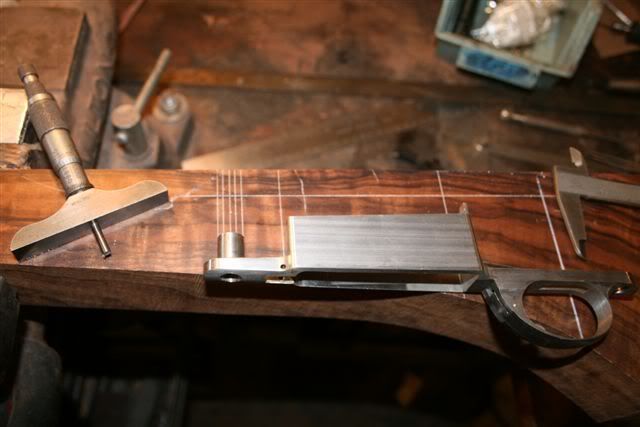 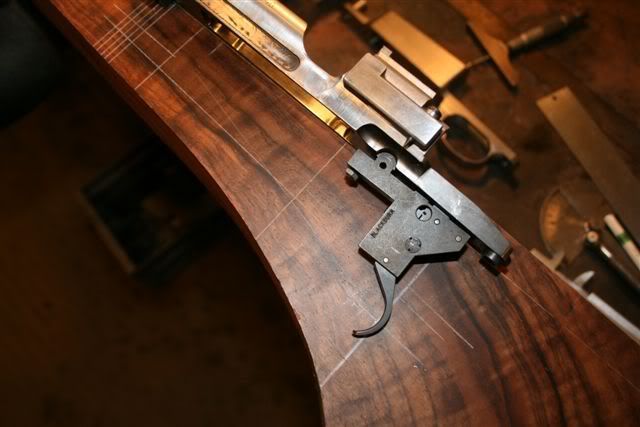 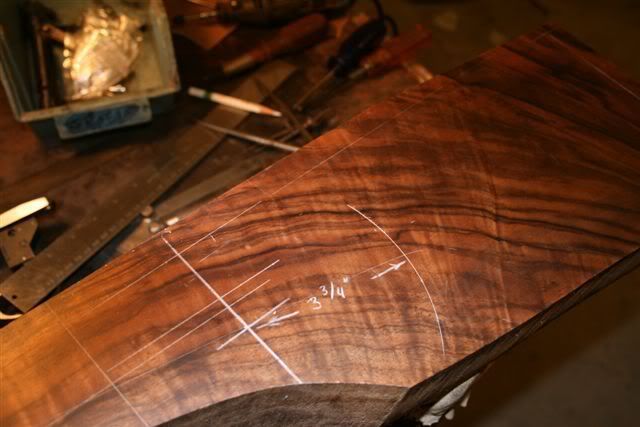 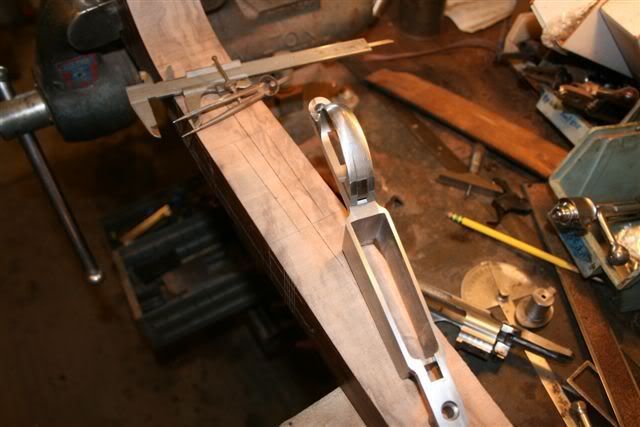 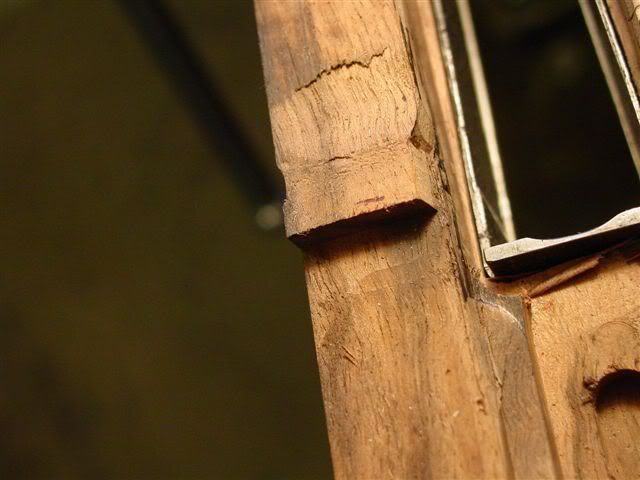 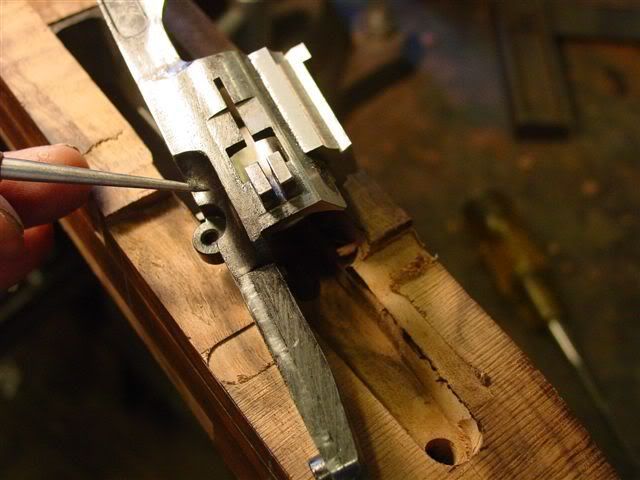 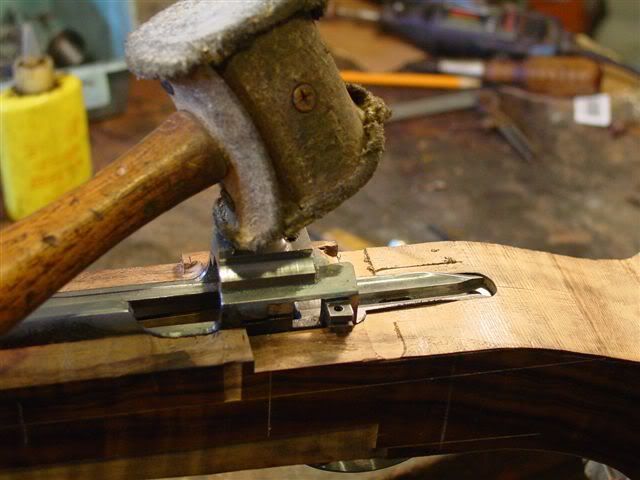    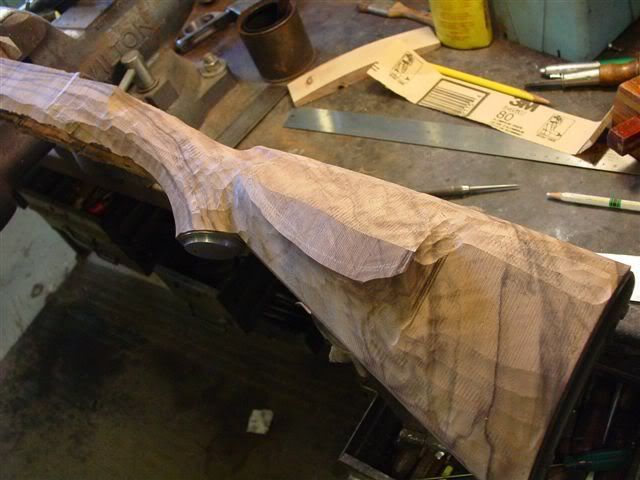 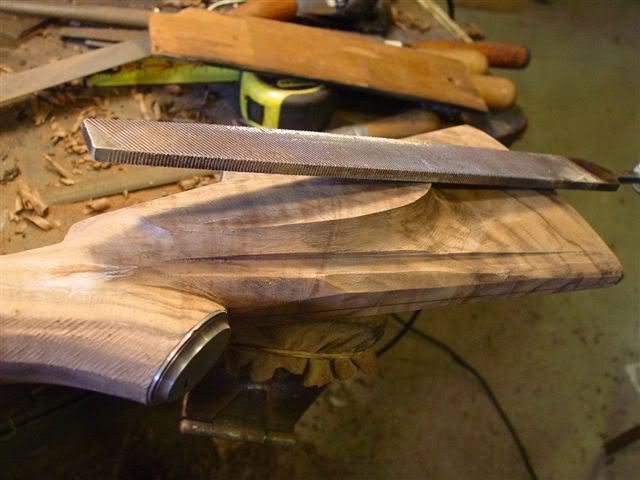 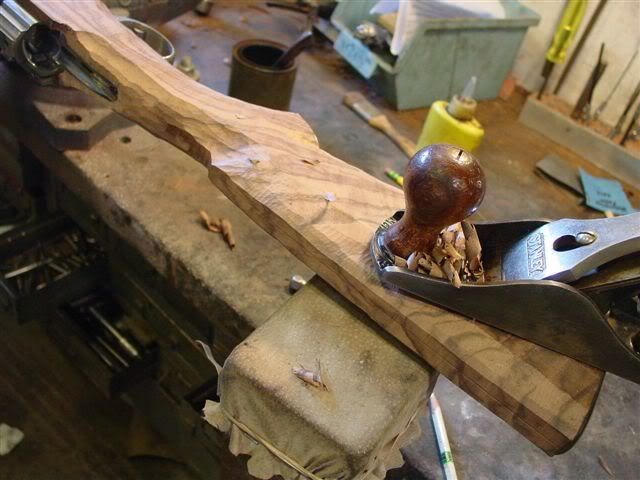 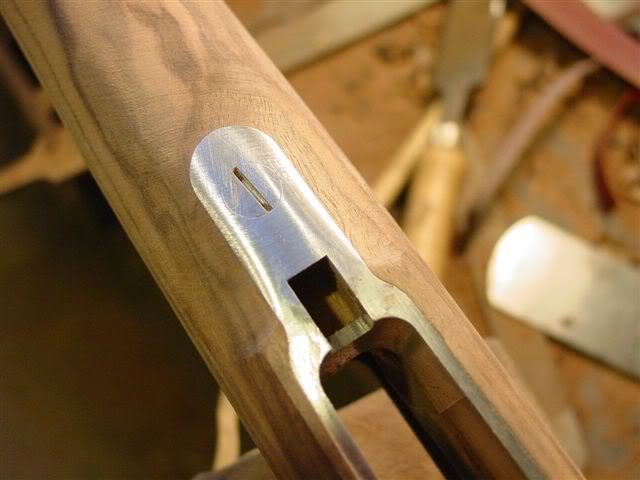 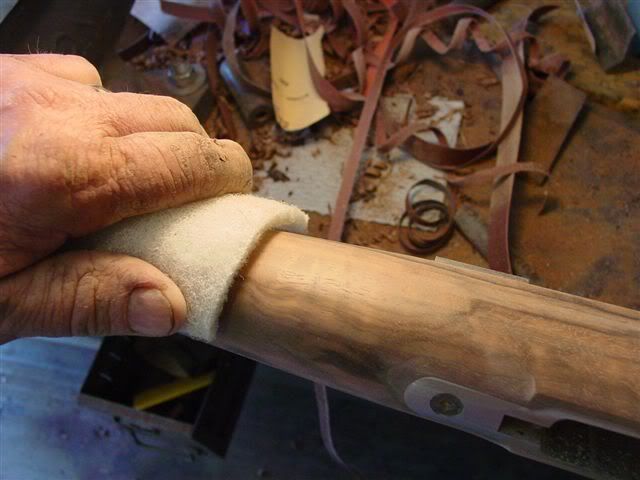 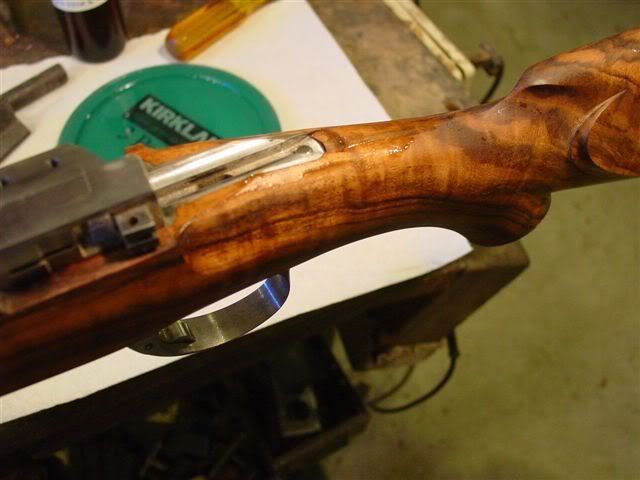 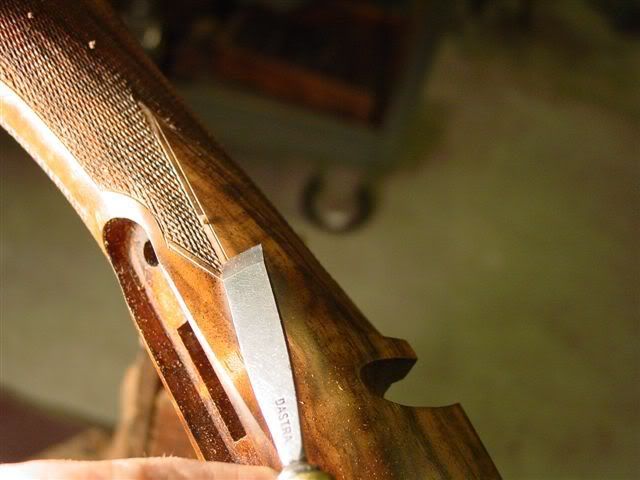 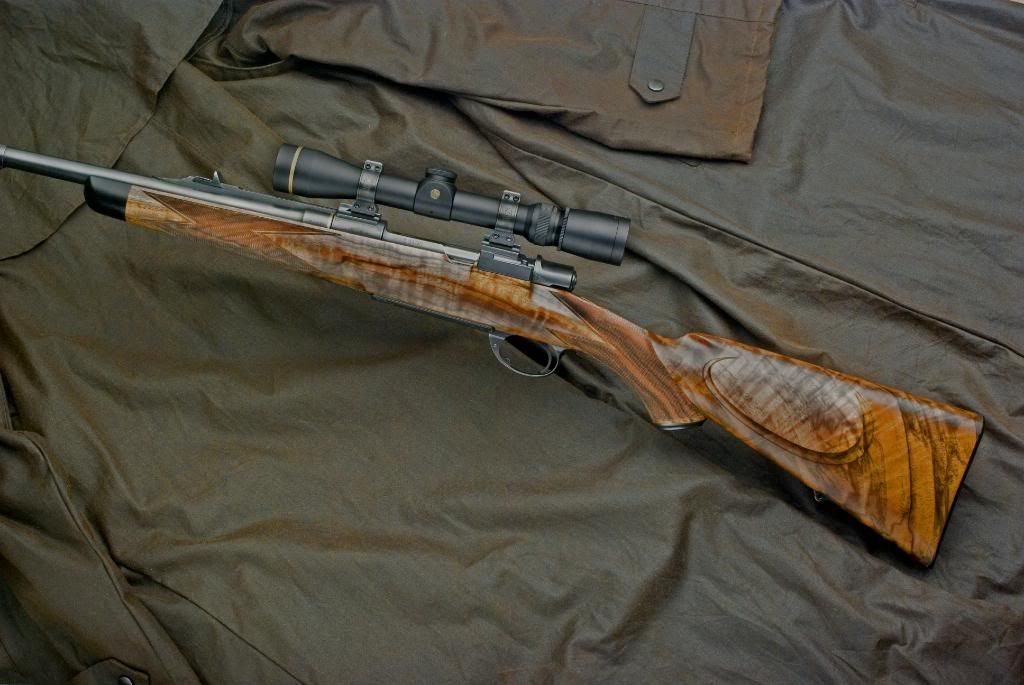 ______________________________ "Truth is the daughter of time." Francis Bacon | |||
|
| One of Us |
Gawd, absolute masterwork, sheer genius in execution! | |||
|
| One of Us |
Hey ForrestB, Are you stating as fact on behalf of Duane that all his custom builds are made this way, or is this series of photograpgh illustrating that Duane is capable of making a stock with a milling machine, chisels and rasps? There is a distinction. There are many stockmakers that are capable to cut a stock out in the way shown in the pics, but whether or not they make all their stocks that way is another story. Economics plays a part in how custom rifles are made. And at $10,000 plus for a rifle they arent getting rich doing it. I know from having visited many ACGG members shops that pantographs are the norm and not the exception. I am not suggesting for a minute that Duane does or doesnt make all his stocks that way. That is for him to tell the world and no one else. There are many people that make the assumption that their stock was made by hand from the get go. But many people also do not ask the question. The photos show how a piece of wood was transformed from a blank into a finished stock, with some of the layout illustrated. Given he makes his bottom metal with CNC machines I would think it a little selective if not hypocritical that wood has to be shaped by hand, (but one can use a milling machine for the inletting), but steel is allowed to be cut with the latest CNC equipment, rather than cut on a manual milling machine and then filed up by hand. Sure, all bottom metal is typically the same, but one only needs a few stock patterns for each action type to be able to supply a few different grip, drop combinations. Many stockmakers develop their own style, Hensley, Allen, Lind, produce stocks that have identifiable lines, their trademark if you like. So a pantograph is the way to go. If having your stock shaped on a pantograph is something that bothers you, then make sure you ask the question before commissioning the work. Beautiful looking rifle BTW. Really nice lines. Really nice... | |||
|
| One of Us |
Duane's way is the way I learned it and the way I do at least 90% of my stocks. But, most of my rifles are one-of-a-kind, with very distinctive and unique features in the sights & stock furniture as well as the dimensions. The particular sights & stock furniture as well as the planned checkering pattern and engraving often determine the actual stock sculpting in some areas. These unique shapes & shaping are some of the features of a truly bespoke product as opposed to a semi-production one. The true custom smiths will almost always change the lines of the action itself in some areas, to avoid the cookie-cutter appearance of the semi-customs turned out by machines. Check out Ed Webber's Hagn as shown in Steve Hughes' book Custom Rifles in Black and White. Simply splendid, and certainly no cookie-cutter work here! I especially like the new lever and the sculpting of the action's bottom tang and the multifaceted top of the receiver ring. Sure, if you want all your rifles to look much the same except for the chambering then go ahead and use machines for everything. After all, that's what Dakota does. Regards, Joe __________________________ You can lead a human to logic but you can't make him think. NRA Life since 1976. God bless America! | |||
|
One of Us |
Interesting question but if I may add my two cents worth....: I really am much more concerned with the finished product.....not too much concerned with the way it's done. I know there are folks that can scrape a wood stock to match the barreled action.....or one can merely full length glass bed it! While i have immense respect and admiration for the skilled craftsman, I'm more concerned with the final product..... I can't afford custom rifles so have learned to make my own. I'm no where near the capability of a man like Duane.....but wind up with some fairly nice guns never the less..... If I had the "big bucks" I'd ask Jim Kobe or other fine artists that post here to make a rifle for me.....and all I'd care about in the end was it's overall appearance.....and will the smith stand behind it.!! I paid for excellence.....and wouldn't care how it was achieved! /////////////////////////////////////////////////////////////////////////// "Socialism is a philosophy of failure, the creed of ignorance, and the gospel of envy, its inherent virtue is the equal sharing of misery." Winston Churchill | |||
|
| One of Us |
goes to show theres no end to learning...and being apprenticed/taught by Hagn would be a great experience.
Duane "cookie cuts" batches of his bottom metal on an CNC, does he not?..which according to your def. makes it semi-custom.,...same with his bolt handles. and I believe Duane will take an negative impression of a barrel, and use it to pantograph machine the underside of the 1/4 rib hes creating.
True custom smith of bespoke rifles, will do what the customer desires, regardless of whether he wants something ultra unique or quite often, a copy of an existing classic/period design that requires little or no changes. By definition: Bespoke English pronunciation: /biˈspoʊk/ is a term employed in a variety of applications to mean an item custom-made to the buyer's specification (personalized or tailored). H&W make/sell custom manufactured squareBridge magnum mausers actions[supplied with traditional style Oberndorf BM, by Blackburn] H&W will create different bridge/receiver ring configurations/geometries if desired. Several people are rather content to have one of those three identical H&W receivers pictured below, without getting their smith to change anything, except maybe cut the bridges for QD rings. which is for practicle purposes not asthetics. One can alter some geometries on that action if one so pleases, but it would not make the rifle anymore or less bespoke, if its made 100% to the customers satisfaction. Mr.Echols has dumped Blackburn BM,in favor of his own higher spec. custom manufactured BM to suite an H&W magnum mauser. The current custom M98 bottom metal you see here, basically follows the theme that Mauser used when it began creating magnum mausers for Rigby in 1904. [ie;integral drop box,bow release,straddle floorplate.] But lets remind people here about your perspective of such products;
Whens the last time you priced new high grade BM and new manufacture high grade Mauser actions?    No common Talleys on this beast, QD rings built inhouse at H&W workshop...  | |||
|
| One of Us |
I agree fully with your sentiments. I would go further than this to say that if one was to have a top end rifle built with a very expensive piece Turkish, I would much prefer that a pattern be made first. Then I could check the lines and hold the stock to make sure it was exactly what I wanted. There are some subtle dimensional differences that can mean the difference between yay or nay, and having an exact copy of what you will get can only give greater confidence in the end result. So for this reason pantographs definitely have their place in the custom/bespoke world of gunmaking. | |||
|
| One of Us |
Purdey use an Hoenig machine for stocks. Trevallion was one of their chief hand stockers. James Purdey & Sons # 26865 circa 1960. 20 bore and last gun made by David Trevallion while at Purdey's Audley House address. When David left Purdey, he had not seen his last gun completed until 46 years later in his home and shop in Maine. Some of the workers at Audley House who contributed to the creation of #26865 are the following. Actioner...Peter Nelson Barrel maker...Brian Frost Ejectors...Peter Finch Stocker...David Trevallion Trigger...David Trevallion Finisher...Peter Chapman Polisher...Dan O'Brien Case hardening and blackening...Dan O'Brien Engraver...Ken Hunt Regulation...Robert Heath    Cast, Bend, Pitch, and Stock Repair Clamping Jig and Setting Bench built by David Trevallion. Purdey O/U in the Trevallion Jig. It was originally built with a 'left-handed' stock. It moved the stock from 1/2" Cast ON (left-handed) to about 7/16" cast OFF (right-handed); took 3 'treatments'...over 4 days. Had to re-fit the pistol grip trigger guard to the stock without removing any wood.  | |||
|
| One of Us |
I will say one thing, "Trax" and that is that you demonstrate very fine taste in your appreciation of sporting guns and rifles. I would rather have a Westley "Droplock" or a McKay-Brown than any of the Purdeys I have seen, but, any of us could "stand" to own that little gem, eh. | |||
|
| One of Us |
Inside the workshop of Shane Thompson. http://www.practicalmachinist....nmaking-shop-124955/ among other machines, he has three pantographs. ..and what looks like an stylish well executed & neatly stocked .416 Mauser bolt rifle. | |||
|
| One of Us |
A rundown on George Hoenig . http://www.thefreelibrary.com/...+gunsmith.-a03152872 What is a master gunsmith? Stripping the term of any excess subjectivity, it usually denotes one who has completed his training in a recognized gunsmithing school, then an apprenticeship in a custom gun shop of good repute. He then spends years of working at his craft. Most master gunsmiths have the paper to prove it, and from these come a few whose virtuosity in steel and wood places them a couple of rungs above the top tier's average. After having known many fine gunsmiths here and abroad, and knowing their work by their individual styles in steel and wood, I find it difficult to define such a man. Like the chap who when asked to define a "camel" replied, "I can't describe one, but I know one when I see one!" I can best do justice to George Hoenig by stating that he is indeed one of the masters of that arcane and difficult art called gunsmithing. To many who see and closely examine a Hoenig gun or stock for the first time, it is also their first experience in viewing a tour de force of a gunswmith's skill. Hoenig's other dimension -- George Hoenig, inventor-designer--is less definable in so many words, because it is 90 percent creativity and engineering with ten percent in shooter-consumer terms. At the motivational root of Hoening's approach to firearms is a consuming determination to produce guns which function better, and the many unique Hoenig designs which cause them to do so. If George had been content to rest on his laurels and stay at the top of a career as a custom maker of superb gunstocks and remarkable metalwork, which he combines into superlative guns, he could simplify his output. But the inventor and engineer in George makes the seemingly conflicting careers of custom gunsmith and engineer-inventor work in tandem. George Hoenig knew long ago as a boy in Germany he wanted to be a gunsmith, and early in life he set about preparing himself for his chosen profession. Hoenig studied the work and techniques of the European masters, the English masters and their finest products, and after his parents brought him to America, George examined every fine American gun he could. He learned how to design and build entire firearms, including pistols and revolvers, and the exotic intricacies of drillings and docuble rifles absorbed his attention. Fortunately, George Hoenig the artist and Hoenig the mechanic were one and the same, so that the manifestation of aesthetics in his creations combined with function to create a better gun or stock. Modele de Luxe .375 Magnum Mauser. I wanted low but strong bases so as to be able to see the open sights with the scope detached, and to have positive return to zero after the dismounted scope was repositioned. George designed and made a superior dovetail top mount which looks and functions as a part of the receiver. Around 1970 I become involved with the development of the .460 G&A cartridge, the inspiration of tom Siatos, the publisher of Guns & Ammo. This round is based on a necked-up .404 (10.75 x 73) case with the body expanded and shoulder moved forward. For a forthcoming Uganda safari, Tom commissioned George to create the ultimate magnum Mauser express rifle. Tom provided a remarkably engraved Brevex magnum action as executed by J. P. Sauer's former top engraver. From this action Hoenig built an express rifle that can only be described as a masterpiece. A thing of beauty though it is, it is a working rifle which lives up to its looks. George polished and honed all internal receiver, bolt and magazine surfaces so no roughness impeded the smooth rise of rounds in the magazine, and then on up to and under the extractor hook, providing a near friction-less chambering. Hoenig characteristically laid the pistol grip back so the forefinger didn't get slammed against the triggerguard in recoil--something which commonly causes flinching. George has a hobby of collecting and restoring or rebuilding drillings, those Germanic three-barreled shotgun-rifle combinations. He has rebuilt a number by installing new rifle barrels or by sleeving the original to replace an obsolete caliber. He refinishes the drilling and often installs his own custom quick detachable scope mounts. George has done a lot of inventive work in designing the finest and strongest quick detachable custom scope mounts, especially for heavy recoiling rifles--but this is not work which Hoenig wants to solicit. With all his research and development of new products for himself and major manufacturers it is mentioned solely to build the Hoenig profile in its full spectrum. His greatest engineering achievement and invention--his precision stock pantograph--was created to uncompromisingly replace hand inletting and shaping of stocks with a machine that inlets more precisely than the finest hand inletting. That Hoenig's machine does this to the degree of precision which I have spelled out is certainly the ultimate in machine design for precision woodworking. When Tom Siatos told me about the machine being able to inlet a sidelock shotgun or double rifle stock with no gaps and within .0005 of an inch, I, as a toolmaker and machinist-gunsmith, was exceedingly skeptical. I had to go to Hoenig's shop in Boise, Idaho to see for myself. The Hoenig precision pantograph inlets so precisely that a slight friction is left as the locks or other parts are pushed into their recesses. Only the small corner radii was cleared out with small chisels, since even the smallest diameter cutters cannot cut a lateral corner--only a bottom corner. As George points out, even the finest stock maker produces at least minor gaps here and there, and by removing the locks and actions of the finest Engish shotguns one can see such minor gaps on most of them. Even these minor gaps are avoided by Hoenig's precision pantograph because it reproduces precisely a pattern created from the gun's original stock--by filling all internal stock inletting surfaces which contact the metalwork, with Micro-Bed compound which then hardens around the metalwork in a gapless mirror impression. The sensitive stylus of Hoenig's pantograph follows these perfectly accurate contours with a precision simply beyond the capabilities of the best hand inletter, including the capabilities of Hoenig himself, who is one of the best. If the customer wants to use the original stock as a pattern, but to have the original comb built up, the pistol grip laid back, or cast-off added or whatever change he might desire, the pattern can be dimensioned so that the stock reflects the changes. The original stock can be split at the grip and a wedge installed to create cast-off, cast-on, or a cheekpiece can be added, or the comb built up. Stocks for antiques or other fine guns which are so badly damaged as to be unsightly or unusable, serve as patterns when repaired so the original styling, dimensions, etc. are retained and then checkering, wood type and color and any original peculiarties and embellishments restored. Again, there is no quess-work in this--it is all done by creating a precise pattern--the machine then reproduces it. A sidelock double shotgun or double rifle, especially of the Holland & Holland design with perhaps an extended upper tang which attaches to the nose of the comb, is one the of the most difficult to stock. Such guns require the finest stockers and the most expensive wood, but Hoenig's pantograph will precisely inlet stocks for such guns as easily as it does simpler designs. However, there is naturally more work in creating a suitably precise pattern for such sidelocks and more handwork in clearing out the many radii with small chisels. While the Boise, I watched Owen Bartlett, Hoenig's assistant, machine inlet a sidelock shotgun and a custom Remington 700 with a Blackburn triggerguard and floorplate. Bartlett cleared out the corners of each stock and then coated the metal where it contacts the inletting, with lamp black and then pushed all actions, lock plates and barrels into place with a slight amount of friction. The coating of lamp black rubbed off on about 90 percent of the surfaces contacting the areas coated. That was enough to convince me! Hoenig also reproduces Kentucky rifle stocks using his extended (60-inch) machine, and he can produce the finest Mannlicher type stocks, which are a Hoenig specialty. Hoenig recently turned out a superb Mannlicher stocked .375 H&H Magnum Model 70 "jungle gun" with a 20-inch barrel for Rober E. Petersen, Chairman of the Board, Petersen Publishing Co. It is one of George's most original efforts. To give an idea of the esteem in which Hoenig's precision pantograph is held by the trade, the following prestigious gunmakers and individual stockmakers are among those owning a Hoenig precision pantograph: Holland & Holland of London, England, Paul Jaeger, JErry Fisher, Bill Dowtin and Pachmayr Gun Works, to name a few. Customers must furnish the barreled actions and the wood, and George carries the ball from there, including all custom work, metal and woodwork as well as furnishing the essential and custom hardware such as steel grip caps, trapped or not, steel buttplates, knurled, trapped or skeleton type and Pachmayr recoil pads. George also furnishes European-type barrel band slide studes to preclude finger damage and to allow a lower slung position to avoid snagging in cover. With so many variables there are not set prices in Hoenig's stock work, but generally speaking, when the customer furnishes the barreled action and wood, the price of a Hoenig custom bolt action rifle begins at $1,500. This includes the finished and checkered stock with all basic hardware, such as seteel grip can (not trapped), sling swivels, recoil pad, chekered bolt release and all metal work carefully polished and blued. Boxlock shotguns or double rifles and forearms are $1,500, but if only the buttstock is needed it is $500 less, or 1/3 the cost of a buttstock and foream set. Extended H&H type upper tangs are extra, and sidelocks minus such tangs are $2,500 as are full-stocked opr Mannlicher-style bolt-action stocks, the latter inlcuding all basic hardware, polishing and blueing as with half-stock sporters. All stocks are checkered inclusive with the price and this is of finest quality. Basically Hoenig creates a classic stock but with whatever individual variations are required. Special attention is given to unusual specifications and less conventional work, but naturally is subject to individual estimates. George Hoenig has invented or designed so many unique and useful items that I have difficulty in selecting outstanding examples, but here are a few. He has been retained by the Pachmayr Gun Works, Los Angeles, California, to develop new products, a position uniquely suited to George, who spent years working there as a top custom gunsmith. I am only now authorized to report that his first product in his new consulting capacity is a revolutionary conversion unit for the Colt Model 1911 Government Model which converts it into an extremely strong single-shot pistol for silhouette shooting with almost any cartridge. It can also be used for varmint hunting, and tthe toolroom original George chambered for the .22 Hornet. One removes the Colt slide and then fits his unit securely the 1911 frame via precisely machine cuts on the unit which is then attached to the Colt frame via integral clamps. It uses an artillery breech of such strenght it can handle cartridges well beyond the power needed for silhouette handgun shooting, and it is a very short and compact breech which leaves plenty of barrel length. It comes with open sight and integrally machined scope mount bases for quick detachability. The original prototype has a ten-inch barrel, but various barrel lengths are contemptlated. This unique conversion unit converts any Colt Model 1911 into an entirely different and vastly more powerful flat-shooting handgun, but just as simply as it is attached, it can be detached and the original slide can be remounted. Hoening has also created a unique system of accurizing a famous pistol for a major manufacturer which is also revolutionary in concept. This design completely rewrites the book on accurizing semi-auto pistols but because of the sensitivity of the development and patent stage of this sensational invention, I am not authorized to reveal the handgun it is designed for. But if you keep this in mind, you will doubtless remember these words when, in the not too distant future, another Hoenig invention becomes a commercial reality. Basically this invention accurizes the semi-auto pistol without any dependence on the slide for controlling repeatable accuracy--and does so with greater reliability and simplicity. Another Hoenig invention is one which experienced handloaders of modern bottlenecked ammunition will appreciate. It is a simple but new and cleverly designed full-length resizing die, or it can be used for neck sizing only. The trouble with most full length or neck sizing dies is that the neck begins to size well before the case body, leaving the case body unsupported while the neck is sized. This means that the neck sizing follows the line of least resistance and not the concentricity of the resized case body which is sized as the shell holder bottoms out. George's sizing die resizes the case body and only after the body is sized, the neck enters a sliding neck sizer bushing and is sized absolutely concentrically with the case body. Sooner or later some loading tool manufacturer is bound to snap up this jewel of a handloaderhs die. And it is not just for the bottlenecked case, but perhaps even more for the straight-tapered case such as the .444 Marlin or the .458 Win. Mag. In George's own words, his stocks are, "A combination of European and American classic. They differ from the typical American classic in that I like the egg-type cheekpiece, rather than the one that flows up into the grip. Yet my cheekpiece differs from the European egg-type. The Germans and Austrians use a cheekpiece that is too flat, too skinny and too pointed. Some of the British overdo it the other way, with great big fat cheekpieces. With my cheekpiece there is no protrusion that can bite the shooter, but where your face lies in the front there is more depth than on the typical American cheekpiece. Because of the need for fore-end pressure I dislike fore-end tips. With a grafted piece of fore-end tip you can't have pressure on the tip itself. You have to move the bearing points behind the tip, otherwise you eventually cause the joint between the non-integral tip and the fore-end to separate. So you have to mechanically set things back of the tip because it creates a weak point for aesthetic reasons only. For these reasons I never install a fore-end tip and can utilize whatever length is there right to the very tip." Hoenig creates suitable cast-off, cast-on and toe-out on his stocks, because, "Bodies aren't built straight up and down like a machine, and the gunstock should be made taking this into consideration, with a little cast-off and toe-out. This will make the gun come up naturally, so that you can just cheek the gun and fire." Hoenig always makes a determination of correct fit to serve the individual physique, based on his own measurements or those provided by the customer. What is the point of such fine custom guns as George Hoenig produces? Any fine custom gun by a first-class maker contains hidden energies which are released when such a gun is shouldered or viewed--that thrill of seeing for the first time the realization of months of planning and dreaming, the great pride of ownership and the joy of showing it off to fellow gun lovers and friends (a great way to convert a non-gun lover), that first sighting-in at the range, and those admiring stares. If it all ended there, George would be disappointed, because he builds his guns and stocks to be shot and hunted with. I used to think that fine guns belonged in the gun cabinet where they can't get scratched or develop that honorable patina some call "handling wear." But after a few safaris I learned that with adequate care, custom guns are great for the hardest hunting. I just ensure that they are carefully wiped down with an oiled or greased cloth nightly and kept in a case when not in use. Just be careful not to take a cased gun from a cool or cold place to a warm one such as a car's trunk which will rapidly cause moisture condensation (sweating) followed by rust. Actually, the George Hoenig story is not the story of a European gunsmith at all, but quite an American story which though beginning in Europe, flowered in America much as did the careers of other American gunsmithing greats, including the nanmes Pachmayr, Bob Owen, Arthur Savage, Borchardt, Paul Jaeger, and on back to those immigrant frontier gunsmiths such as the Schoyens and others who are integral to the great American mosaic of craftsmanship. | |||
|
| One of Us |
G'Day Fella's, A couple of years ago, an old mate of mine was a bit tight for money. He telephoned and asked me if I knew anybody that may be interested in one of his rifles, that I already had in storage! Half an hour later, I telephoned him back with My offer to purchase the rifle off him but on one proviso! And that was, if he was financial enough again, in the next few years, he could by it back off me for the same price, plus a beer! He immediately said Yes! To cut a long story short, we exchanged dollars and I took possession of a rare and unique rifle! This particular custom rifle, was made for my old mate, in 1992 by the Australian artisan, Ross T Waghorn! The basic details are as follows; Browning Safari (M98), magnum length action, Caliber, .404 Jeffery, Australian grown, exhibition grade English Walnut stock, Not only did Mr Waghorn do the stock work on this rifle, he also done all of the metal work (except for the engraving; Phil Vinicombe did that), this included fitting and chambering the Douglas barrel, making and fitting the 1/4 rib, English style sling swivels etc etc This is a work of art that just so happens to shoot! Mr Waghorn still does all the stock work by hand, over a period of many months! That means No milling machines or Electric Hand Tools at all, for any of the wood removal! I could go on for ever but I'm sure you get the picture! Doh! Homer Lick the Lolly Pop of Mediocrity Just Once and You Will Suck For Life! | |||
|
| Powered by Social Strata | Page 1 2 |
| Please Wait. Your request is being processed... |
|
 The Accurate Reloading Forums
The Accurate Reloading Forums  THE ACCURATE RELOADING.COM FORUMS
THE ACCURATE RELOADING.COM FORUMS  Rifles
Rifles  Custom Built Rifles
Custom Built Rifles  Who really builds your custom...& how much does it matter.
Who really builds your custom...& how much does it matter.

Visit our on-line store for AR Memorabilia

